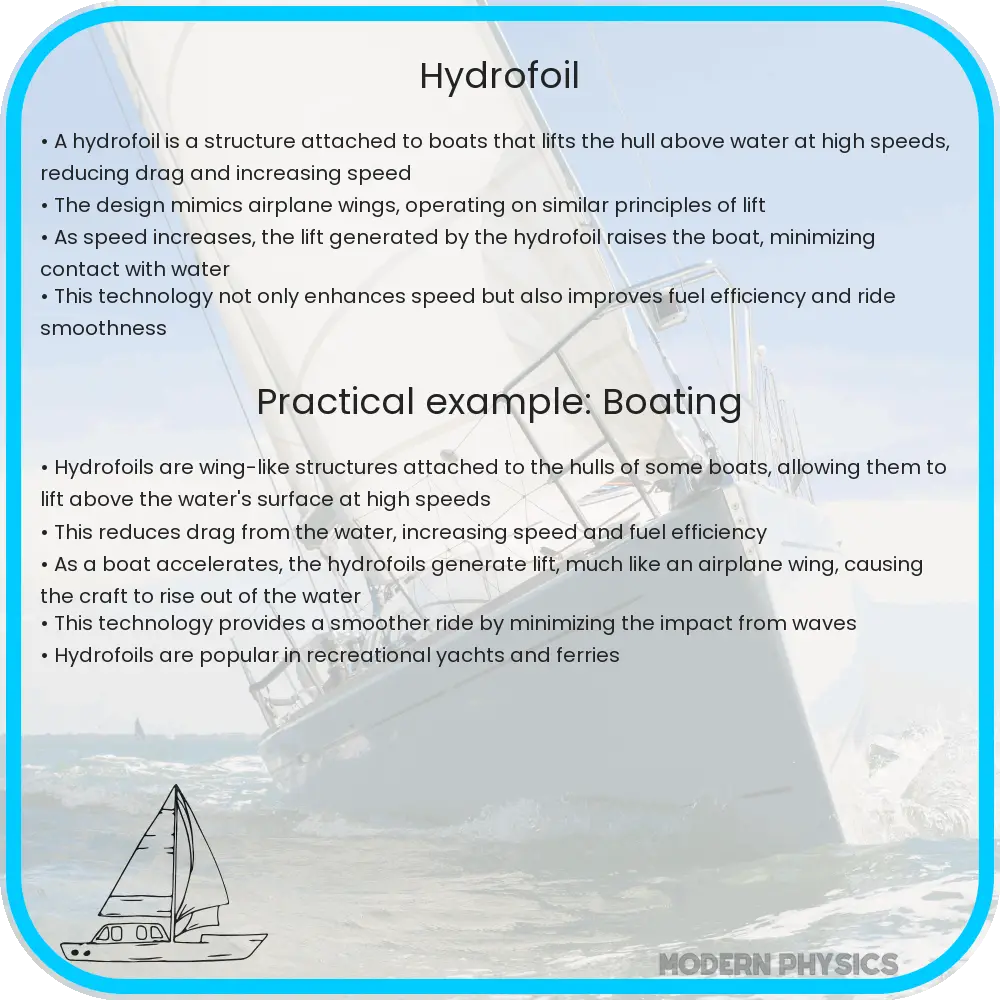Explore the efficient design, lift dynamics, and speed of hydrofoil technology, and its impact on maritime engineering and environment.

Understanding Hydrofoil Technology: Design and Dynamics
Hydrofoils, a remarkable feat in maritime engineering, have transformed the way we perceive water transportation and sports. By leveraging the principles of aerodynamics and applying them to watercraft, hydrofoils achieve high speeds and improved efficiency. This article delves into the intricate design elements, lift dynamics, and speed capabilities that make hydrofoils a pinnacle of modern marine technology.
The Design of Hydrofoils
At the core of a hydrofoil’s design is its wing-like structure, known as a foil. The foil is submerged in water and, much like an airplane wing, is designed to produce lift as the vessel moves forward. This lift raises the hull above the water’s surface, significantly reducing drag and allowing for greater speeds. The shape, angle, and material of the foil are critical factors that influence the efficiency and stability of the hydrofoil.
Lift Dynamics
The principle that governs the lift of a hydrofoil is Bernoulli’s equation, which explains how the pressure of a moving fluid (in this case, water) decreases as its velocity increases. The foil’s design, with a curved upper surface and a flatter bottom, creates a pressure difference. Water moves faster over the top surface, creating a low-pressure zone, while slower moving water beneath the foil generates higher pressure. This pressure differential results in an upward force, lifting the vessel.
- Aspect Ratio: The aspect ratio of the foil, which is the ratio of its length to width, is a crucial design element. A higher aspect ratio generally provides greater lift and efficiency.
- Angle of Attack: The angle of the foil relative to the water’s flow also affects lift. A greater angle can increase lift but also increases the risk of stalling.
Speed Considerations
Speed is a standout feature of hydrofoils. The reduction of drag by lifting the hull out of water allows hydrofoils to reach speeds significantly higher than conventional watercraft. Factors like foil design, water conditions, and vessel weight play pivotal roles in determining top speed. Hydrofoils are thus popular in racing and high-speed transport applications.
However, higher speeds also pose challenges, such as increased instability and the risk of ‘ventilation,’ where air is drawn down around the foil, reducing its effectiveness. Advanced hydrofoil designs address these issues through automated control systems and specialized foil shapes.
In conclusion, hydrofoils embody a harmonious blend of physics, engineering, and design, creating vessels that glide above the water’s surface with grace and speed. The next section will further explore the applications, environmental impact, and future prospects of hydrofoil technology.
Applications and Environmental Impact of Hydrofoils
Hydrofoils find their applications in various domains, ranging from commercial transportation to recreational sports. In the realm of passenger ferries, hydrofoils provide a fast and efficient means of travel, especially in archipelago regions. In sports, hydrofoil surfboards and sailboats have gained popularity for their exhilarating speed and agility.
Environmental Considerations
One of the significant advantages of hydrofoils is their reduced environmental impact compared to traditional vessels. By minimizing hull drag and maximizing fuel efficiency, hydrofoils lower fuel consumption and reduce greenhouse gas emissions. Moreover, their elevated design reduces the impact on marine life by avoiding direct contact with the water’s surface, thus lessening disturbances to ecosystems.
Future Prospects and Innovations
The future of hydrofoil technology shines bright with continuous advancements. Electric hydrofoils, combining the benefits of electric propulsion with hydrofoil efficiency, are emerging as a sustainable option. Furthermore, advancements in materials technology, such as the use of carbon fiber, are making hydrofoils lighter, stronger, and more durable.
- Automated Control Systems: To enhance stability and performance, future hydrofoils may incorporate more sophisticated automated control systems, enabling them to adapt dynamically to varying water conditions.
- Hybrid Designs: The integration of hydrofoil technology with other maritime innovations, like catamarans, presents opportunities for creating hybrid designs that could revolutionize water transportation.
Conclusion
Hydrofoil technology, with its blend of speed, efficiency, and environmental consciousness, stands as a testament to human ingenuity in marine engineering. The synergy of aerodynamic principles and maritime design not only provides a faster mode of water transportation but also opens new possibilities for sustainable and efficient maritime travel. As we advance, the potential for further innovation in hydrofoil technology continues to expand, promising a future where travel across the water’s surface is faster, cleaner, and more efficient than ever before.
In essence, hydrofoils are not just a mode of transportation; they are a symbol of our relentless pursuit to harmonize speed, efficiency, and ecological responsibility in our journey across the blue expanses of our planet.
